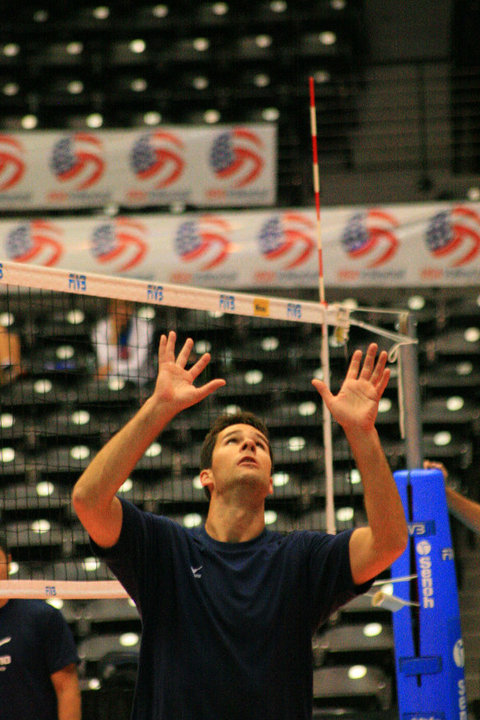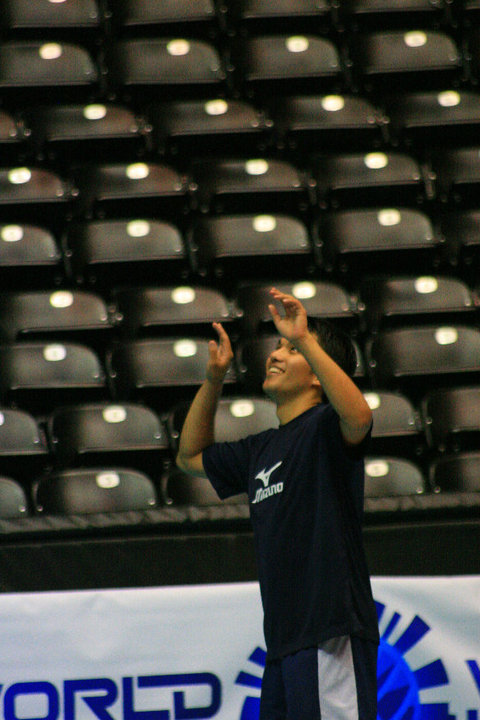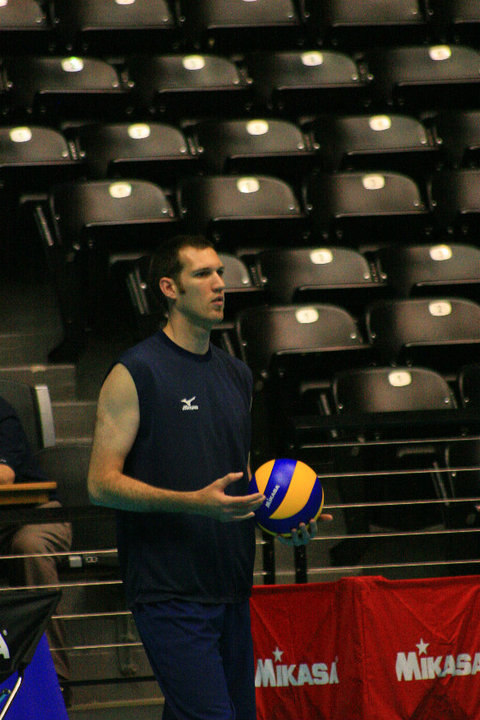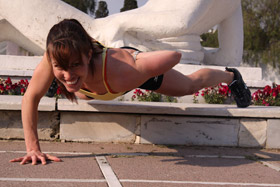Volleyball Warm-Up Do’s and Dont’s with Kari Schneider
How is your warm-up working for you? Are you sitting around stretching your hamstrings? Are you jogging in circles? Should you stretch statically or dynamically? Let me just tell you…
Here is the question…How should an athlete warm-up and what type of stretching should they do pre-workout or match and post? I have been asked this question so many times that my answer is pretty rehearsed by now-so here is the short version… After working with thousands of athletes and clients my answer is simple, pre training or competition is dynamic and post is static. Now of course there is always the exception to the rule but I’ll give you some of the reasons why I have answered this way.
1. What is your goal?
This is the most important question. Simply due to the fact that when you are an athlete or person training for specific results you need to know that your training has purpose. Are you warming up to play a game that requires explosive, precise movements like volleyball, football, tennis, basketball etc? Or are you looking to increase your range of motion (ROM)? When you ask yourself what you are trying to accomplish the answer suddenly becomes clearer. If you want neurological preparation and need your body to be ready to perform, you will not be properly prepared for explosive performance if you have only done static stretching prior to performing. Period.
2. What is a Dynamic Warm-up?
This is my definition and I think you will find that many athletes, coaches and strength coaches will agree. A dynamic warm-up is a series of preparatory exercises- progressive in nature, done with specific movements of increasing intensity to:
– elevate the heart-rate,
– elevate the core temperature,
– while activating and preparing the nervous system, joints and muscles for the upcoming sport specific activity.
3. Why do I want to prepare with a dynamic warm up?
• Increased SPEED and FORCE of contraction and relaxation of warmed muscles.
• Dynamic exercises reduce muscle stiffness
• Probability of overstretching a muscle (strains or pulls) and causing injury lessens
• Greater economy of movement because of lowered viscous resistance within warmed muscles.
• Facilitated oxygen utilization by warmed muscles because hemoglobin releases oxygen more readily at higher muscle temperatures.
• Increase in hormones to facilitate use of more CHO & fatty acids for energy production.
• Facilitated nerve transmission and muscle metabolism at higher temperatures; a specific warm up can facilitate motor unit recruitment required in subsequent all out activity
• Increased blood flow through active tissues as local vascular beds dilate, increasing metabolism and muscle temperatures=less stress on heart!
• Allows the heart rate get to a workable rate for beginning exercise.
• Increased Synovial Fluid in joints
• More mentally focused on the training or competition (increase focus, visualize strategy)
That’s right! All of these physiological effects from increasing your blood flow, heart rate, body temperature and choosing key movements to prepare your neuromuscular system.
4. Don’t believe me? Then check out some research on the topic!
• Better performance in T-shuttle run, underhand MB throw, and 5 step jump after Dynamic Warm up vs static and no warm up. McMillan 2006
• *Improved long term performance after 4 weeks of Dynamic Warm-up vs static stretching warm up. Herman & Smith 2008
a. Increase in…Quad peak torque, broad jump, med ball throw, sit-ups, push-ups
b. Faster times for 300yd shuttle, 600m run
c. Enhanced muscular strength, endurance, agility and anaerobic capacity
• Trained women showed no change in vertical jump after static or ballistic stretching. Unick 2005
• Best warm up for vertical jump in College male athletes is 10% BW weighted jumps vs. submaximal jumps, no warm up or static stretching. Burkett 2005
• A dynamic warm-up performed with a vest weighted with 2% of body mass may be the most effective warm-up protocol for enhancing jumping performance in high school female athletes. Faigenbaum, McFarland, et al. 2006
• Less accumulation of blood and muscle lactate during intense dynamic exercise preceded by active warm-up vs. passive. Gray & Devito 2002
• Active dynamic warm up increase 20m sprint performance vs static. Fletcher 2004
Whoa! What does all of that mean?! Translated from scientific terms it simply means that explosive movements (lower body and upper body) are improved after a dynamic warm-up. Fitness is also improved along with agility! It means you can sprint faster and you’re not as likely to have the muscle heaviness and burn. When you care about the quality of your performance, your warm up choice is simple.
5. What about Range of Motion?
I am a firm believer in having appropriate range of motion for the sport being performed! I expect my volleyball athletes to be able to minimally touch their toes! That gives me an indication of their back and hamstring range of motion. This is important considering the positions that many of the reception players have to be in when digging a ball. If their hamstrings and adductors have poor range of motion then it is highly likely they will become injured when trying to get low to the ground quickly. If I’m working with a different athlete, say a gymnast or dancer, then they need much more range than simply touching their toes…so as you can tell, the range of motion is sport, position and person specific! The dynamic warm-up will help improve functional ROM but for more efficient flexibility results focus on your flexibility separately.
6. Can I use Static Stretching to improve flexibility?
Most definitely! But, if you are trying to improve range of motion, don’t expect your 5 minutes of post workout stretching to do the trick! You need to spend more time to make increases in tissue length. This is where Yoga is an excellent tool. An hour spent in yoga a few times a week will do wonders for athletes struggling with tight hips, back and shoulders. Hot Yoga (bikram or moksha) is another great choice but beware of the sweat loss if you are in heavy training or competition because you’ll need considerable recovery from the heat and sweat loss. I’d suggest hot yoga in the off-season. PNF stretching (proprio-neuromuscular facilitation) is another more intense form of stretching that will provide results faster than static stretching alone. It involves contract/relax techniques and there are a few methods of doing it but your best bet is to have someone experienced (coach or therapist) teach you how to do it with a partner. Here is a little more research to chew on…
• Gastrocnemius (calf muscle) EMG 17% greater post static stretch but vertical jump 5.6% lower. Wallmann 2005
• Yoga lessened symptoms of DOMS (delayed onset muscle soreness). Boyle 2004
• PNF stretching at 3 sec, 6 sec and 10 sec of hold relax all produce significant gains in ROM Bonnar 2004
7. How long should the warm-up take?
Typically the warm-up will take 15-25 minutes. You want to warm up for your dynamic warm up by jogging and breaking a sweat initially (which is usually about 5 minutes) and then start the dynamic movements. There are several components that play into this answer, but here are two key factors. The training cycle -you may need to reserve as much energy as possible because of a very intense time of the season. Temperature and humidity- in higher temperatures and humidity you will find that your warm-up requires less time but a real focus on efficiency. In lower temperatures you may have to repeat movements multiple times before you get the physiological effects. Of course the sport, and time until the match or practice key too, just practice your warm up sequence in training so it feels just right prior to competition!
One more thing… As I said, there is always the exception to the rule. I have found with many veteran or older athletes that they want/need a moment for one or two static stretches prior to training or competition. This is usually because they have a particular area that is always a little tight. This might be due to an old injury or extended amounts of time in one sport or movement pattern that creates a specific tightness. In this case, as long as they do a full sport specific dynamic warm-up they will be best prepared. The short amount of time they do the static stretch gives them the mental confirmation of whether that area is more or less reactive that day and how they need to proceed to deal with it (longer warm-up, easing into practice drills or more ROM work after practice). This is ok and very specific to individuals who know their bodies very well. As a coach, you can allot 5 minutes sometime during a dynamic warm-up to address this. With younger athletes with less experience, this extra time for one or two static stretches is unnecessary and often detracts from their preparatory focus.
Thank you so much Kari!
*Kari Schneider is one of Canada’s top strength and conditioning coaches. She has helped to bring high performance athletes to the Olympics, injured athletes back stronger than ever and private clients to abilities they never knew they had! Click here for more info.
(images: Evan Kisner)






One Comment
Leave a ReplyOne Ping
Pingback: Are you warming up incorrectly? – Volleyball Drills from Division 1 athletes